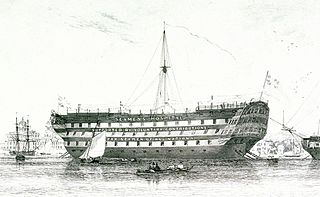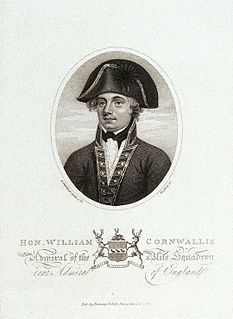
The Siege of Yorktown, also known as the Battle of Yorktown, the Surrender at Yorktown, German Battle or the Siege of Little York, ending on October 19, 1781, at Yorktown, Virginia, was a decisive victory by a combined force of American Continental Army troops led by General George Washington and French Army troops led by the Comte de Rochambeau over a British Army commanded by British peer and Lieutenant General Charles Cornwallis. The culmination of the Yorktown campaign, the siege proved to be the last major land battle of the American Revolutionary War in the North American theater, as the surrender by Cornwallis, and the capture of both him and his army, prompted the British government to negotiate an end to the conflict. The battle boosted faltering American morale and revived French enthusiasm for the war, as well as undermining popular support for the conflict in Great Britain.

HMS Dreadnought was a Royal Navy 98-gun second rate. This ship of the line was launched at Portsmouth at midday on Saturday, 13 June 1801, after she had spent 13 years on the stocks. She was the first man-of-war launched since the Act of Union 1800 created the United Kingdom of Great Britain and Ireland, and at her head displayed a lion couchant on a scroll bearing the Royal arms as emblazoned on the Standard.

Suffren was a Suffren-class frigate of the French Navy, designed to protect a fleet against air threats, surface ships, submarines, and, to a lesser extent, provide firepower against land objectives. She is the sister-ship of Duquesne, and was decommissioned in 2001. She was the seventh French vessel named after the 18th century admiral Pierre André de Suffren; her artillery turrets are named after ships commanded by the marquis of Suffren: turret n°1 is named Héros ("hero") after the ship of the line Héros, and turret n°2 is named Fantasque, after the ship of the line Fantasque.

Admiral Sir William Cornwallis, was a Royal Navy officer. He was the brother of Charles Cornwallis, the 1st Marquess Cornwallis, British commander at the siege of Yorktown. Cornwallis took part in a number of decisive battles including the Siege of Louisbourg in 1758 and the Battle of the Saintes but is best known as a friend of Lord Nelson and as the commander-in-chief of the Channel Fleet during the Napoleonic Wars. He is depicted in the Horatio Hornblower novel, Hornblower and the Hotspur.

HMS Cornwallis was a Duncan-class pre-dreadnought battleship of the Royal Navy. Built to counter a group of fast Russian battleships, Cornwallis and her sister ships were capable of steaming at 19 knots, making them the fastest battleships in the world. The Duncan-class battleships were armed with a main battery of four 12-inch (305 mm) guns and they were broadly similar to the London-class battleships, though of a slightly reduced displacement and thinner armour layout. As such, they reflected a development of the lighter second-class ships of the Canopus-class battleship. Cornwallis was built between her keel laying in July 1899 and her completion in February 1904.
USS Don Marquis (IX-215), an unclassified miscellaneous vessel, was the only ship of the United States Navy to be named for that writer, poet, and artist. Her keel was laid down by the California Shipbuilding Corporation, in Los Angeles, California, as a Type EC2-S-C1 hull under Maritime Commission contract number 1874. She was launched on 23 August 1943.

HMS Minerva was a 38-gun fifth-rate Royal Navy frigate. The first of four Minerva-class frigates, she was launched on 3 June 1780, and commissioned soon thereafter. In 1798 she was renamed Pallas and employed as a troopship. She was broken up in 1803.
Five or six ships of the Royal Navy have been named HMS Cornwallis, after Admiral Sir William Cornwallis.

HMS Cornwallis was a 74-gun third rate ship of the line of the Royal Navy, launched on 12 May 1813 at Bombay. She was built of teak. The capture of Java by USS Constitution delayed the completion of Cornwallis as Java had been bringing her copper sheathing from England.
Four ships of the Royal Navy have borne the name HMS Akbar, the Arabic word for Great. Two others were planned but never commissioned:

HMS Cornwallis was a Royal Navy 54-gun fourth rate. Jemsatjee Bomanjee built the Marquis Cornwallis of teak for the Honourable East India Company (EIC) between 1800 and 1801. In March 1805 Admiral Sir Edward Pellew purchased her from the Company shortly after she returned from a voyage to Britain. She served in the Far East, sailing to Australia and the Pacific Coast of South America before returning to India. In February 1811 the Admiralty renamed her HMS Akbar. She captured forts and vessels in the Celebes and Amboyna, and participated in the invasion of Isle de France, and the 1811 invasion of Java. She also served in the West Indies before being laid up at Portsmouth in December 1816. She then stayed in Britain in a number of stationary medical and training capacities until the Admiralty sold her in the 1860s.
HMIS Cornwallis (L09) was an Aubrietia-class sloop, originally built during World War I and commissioned as HMS Lychnis in the Royal Navy (RN) in 1917. She was transferred to the Royal Indian Marine (RIM) and commissioned as Cornwallis in 1921.

Earl Cornwallis was a three-decker East Indiaman launched in 1783 on the Thames. She made seven voyages for the British East India Company (EIC). Then in 1800 transported convicts from England to New South Wales. By 1809 she was no longer listed.
Michael Hogan (1766-1833) was an Irish-born shipowner involved in the early settlement of Australia.
Several vessels have borne the name Cornwallis, for Charles Cornwallis, 1st Marquess Cornwallis:
Many ships have been named Betsey or Betey:
Marquis Cornwallis was launched at Sunderland in 1802. She traded widely, to the West Indies, the Iberian peninsula, and the Baltic. The American privateer Chasseur captured her in 1814 but released her as a cartel. She was wrecked in 1823.
This page is based on this
Wikipedia article Text is available under the
CC BY-SA 4.0 license; additional terms may apply.
Images, videos and audio are available under their respective licenses.











